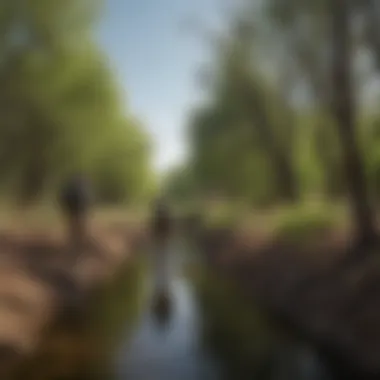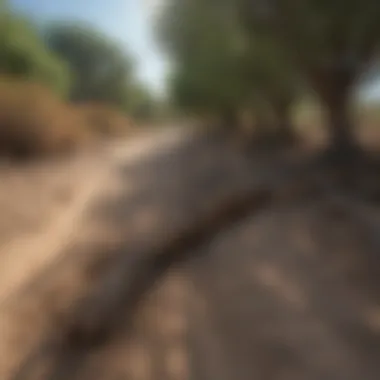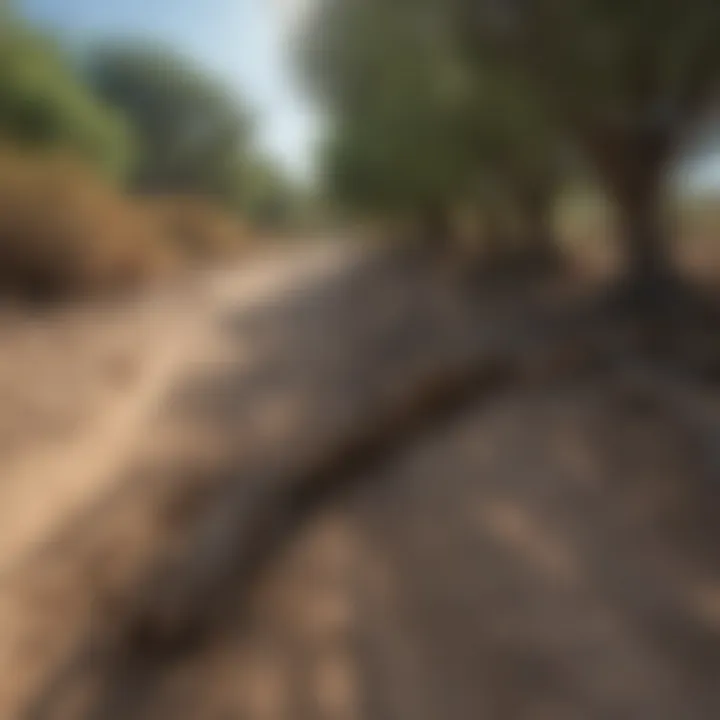Tamarisk: Impacts and Innovative Management Strategies


Intro
Tamarisk, often referred to as salt cedar, poses significant challenges to ecosystems along the North Shore. This invasive species has garnered attention due to its ability to outcompete native flora, affecting biodiversity and altering habitat dynamics. The deeper implications of tamarisk’s presence extend beyond immediate ecological concerns, impacting local water resources and soil health. This article aims to dissect these complexities, exploring not only the ecological impacts of tamarisk but also effective management strategies and restoration efforts.
By understanding the intricacies of tamarisk’s integration into woodland ecosystems, we can better address the challenges it brings and outline paths for sustainable forestry practices.
Understanding Woodland Ecosystems
Woodland ecosystems serve as vital landscapes teeming with biodiversity. They contribute to the health of our planet in several essential ways. A heightened awareness of these functions is crucial for effective management and conservation strategies.
Importance of Biodiversity in Forests
Biodiversity enhances ecosystem resilience. A diverse range of species allows ecosystems to better withstand disturbances such as climate change and invasive species, like tamarisk. When tamarisk dominates, the loss of native plants can lead to diminished biodiversity, affecting various forest layers and the wildlife reliant on native species.
- Native species provide essential habitat.
- A diverse gene pool supports adaptability.
- Healthy forests improve water quality and reduce erosion.
An ecosystem devoid of such diversity becomes more susceptible to alterations that could be unfavorable for its inhabitants.
Role of Forests in Climate Regulation
Forests serve as critical carbon sinks. They capture carbon dioxide from the atmosphere and store it within biomass and soil, mitigating the impact of greenhouse gases. By outcompeting native tree species, tamarisk can disrupt this carbon storage function. This disruption not only affects local climates but can have broader implications.
The interplay between tamarisk and other species, especially concerning moisture and sunlight, needs to be closely monitored to mitigate long-term environmental consequences.
"The introduction of invasive species like tamarisk challenges the equilibrium of woodland ecosystems, necessitating immediate action to restore native biodiversity."
Sustainable Forestry Practices
Implementing sustainable forestry practices can prevent excessive spread of invasive species and support overall ecosystem health. It is imperative to understand both the principles and successful case studies in this realm to develop replicable strategies.
Principles of Sustainable Forestry
Sustainable forestry involves managing forest resources to meet current needs without compromising future generations. This concept contains several key components:
- Maintaining biodiversity and ecosystem functions.
- Minimizing environmental impacts during logging and land use.
- Prioritizing the health and productivity of forest ecosystems.
Engagement in practices like selective logging and the establishment of buffer zones can help maintain biodiversity and prevent the encroachment of invasive species.
Case Studies of Successful Implementations
Examining successful instances of sustainable forestry reveals best practices that can be adapted to address the tamarisk issue:
- In Colorado, the mitigation of tamarisk along riverbanks combines mechanical removal and replanting of native species.
- In California, the Forest Stewardship Council certified lands that focus on preserving water resources and native biodiversity.
These examples illustrate the feasibility of managing invasive species utilizing sustainable methods.
Woodland Stewardship Techniques
Woodland stewardship integrates diverse strategies to promote the health of forest ecosystems. Comprehensive forest management plans and conservation strategies are vital components of this effort.
Forest Management Plans
An effective forest management plan outlines specific strategies to enhance habitat quality and protect biodiversity.
- Such plans often include risk assessment of invasive species like tamarisk.
- They prioritize the restoration of native forest structures and functions.
Conservation Strategies
Conservation approaches can be tailored to local ecosystems to effectively address invasive species challenges. Some strategies include:
- Regular monitoring of flora and fauna to track biodiversity levels.
- Collaboration with local communities to engage in restoration efforts and education about invasive species.
These techniques not only address the immediate effects of tamarisk but also contribute to longer-term ecosystem resilience, improving management practices as environmental conditions evolve.
Intro to Tamarisk


Tamarisk has become a focal point in discussions surrounding invasive species and their impact on native ecosystems. Understanding tamarisk is essential for several reasons. It provides insights into how such species adapt and thrive in new environments, often at the detriment of local biodiversity. The importance of discussing tamarisk lies not only in its ecological implications but also in the management strategies that have evolved in response to its presence.
The introduction of tamarisk to non-native areas has resulted in significant ecological shifts. These shifts can alter the composition of local flora and fauna, affecting everything from soil health to water availability. By examining these aspects, stakeholders can better understand the challenges posed by tamarisk and develop effective strategies for management and restoration efforts.
Defining Tamarisk
Tamarisk refers to a group of shrubs and small trees belonging to the genus Tamarix. These species are known for their resilience and ability to thrive in arid conditions. Their characteristics include scale-like leaves and pink or white flowers, which are not particularly attractive to many pollinators. Their potential for rapid growth and establishment in diverse habitats is particularly concerning in regions where they encroach upon native species, leading to substantial ecological ramifications.
Historical Context of Tamarisk Prologue
The introduction of tamarisk species into North America dates back to the 1800s, originally for purposes including erosion control and ornamental use. The first recorded introduction was noted in the early 1800s, particularly in the southwestern United States. Over time, these species spread beyond their intended areas, facilitated by their hardy nature and adaptability.
As tamarisk populations expanded, they replaced many native plants, especially in riparian areas. Historical records indicate that tamarisk quickly dominated these environments, leading to changes in local ecosystems. This shift has emphasized the need for effective management approaches and highlighted the importance of understanding the history of tamarisk to combat its ongoing spread.
Managing tamarisk effectively requires a comprehensive understanding of its history and ecological impact.
In summary, the significance of tamarisk lies in its dual role as both a resilient invasive species and a catalyst for ecological change. Understanding its definition and historical context serves as a foundation for further discussions on its ecological impact and management strategies.
Ecological Impact of Tamarisk
The ecological impact of tamarisk is a significant concern, especially on the North Shore. This invasive species, known for its adaptability and resistance to various environmental challenges, poses multiple threats to local ecosystems. Understanding these impacts is crucial for forestry professionals and conservationists to devise methods for effective management and restoration of affected areas.
Effects on Native Flora and Fauna
Tamarisk directly competes with native plants for space, sunlight, and nutrients. Its dense thickets can inhibit the growth of local flora, reducing biodiversity. The displacement of native species often leads to a cascade of effects on the ecosystem. For instance, many animals rely on native plants for food and habitat. As these plants decline, the animal populations that depend on them may also suffer.
Bird species are particularly affected. Many rely on specific native plants for nesting and foraging. When these native species are crowded out, bird populations may decline, disrupting the ecological balance. This shift can upset the food web, leading to further imbalances within the ecosystem.
Alteration of Soil Composition
Tamarisk alters the soil composition in multiple ways. It has a unique ability to take up salts from the soil and excrete them through its leaves, leading to increased salinity in the surrounding soil. High salinity levels can inhibit the growth of other plants, including many native species that are not salt-tolerant. This change in soil quality can lead to long-term repercussions for the entire ecosystem.
Additionally, the extensive root systems of tamarisk can change the structure of the soil. This alteration can impact the penetration of water and the overall health of the soil microbiome. These changes are often unfavorable for native plant life, compounding the issue of native species decline.
Water Usage and Resource Competition
Tamarisk is highly adept at extracting water from the ground. Its roots penetrate deep into the soil, allowing it to access moisture that might otherwise support shallow-rooted native plants. This significant water usage creates competition between tamarisk and local flora, leading to a decline in the availability of water.
The impact of this competition extends beyond plants. Reduced water availability affects other wildlife that relies on these plants and their habitats. Aquatic ecosystems can also be impacted, especially in areas where water levels are already low. This dynamic creates a situation where tamarisk not only benefits from resources but also actively depletes what is available for others.
Understanding the ecological impacts of tamarisk enables better management decisions. The adaptation and resilience of this species highlight the need for strategic approaches in controlling its spread while restoring native ecosystems.
Tamarisk on the North Shore
Tamarisk, an invasive species, has become an integral part of discussions concerning the ecological health of the North Shore. Understanding its geographic distribution and dominance, along with climate considerations, provides valuable insights for effective management and restoration. The North Shore, characterized by its unique ecosystems, faces specific challenges posed by tamarisk.
Geographic Distribution and Dominance
Tamarisk thrives in areas with disturbed soils and can quickly become dominant in ecosystems where it is established. On the North Shore, the plant often appears along riverbanks, coastal areas, and disturbed habitats. Its wide adaptability allows tamarisk to colonize various environments, leading to significant displacement of native species.
- Aggravating Factors: The geographical spread of tamarisk is exacerbated by human activities such as agriculture and urban development, which create open areas for its establishment.
- Impact of Dominance: Tamarisk's ability to form dense thickets can significantly reduce biodiversity. This overcrowding prevents sunlight from reaching native plants, effectively choking out competition. The hybridization of tamarisk species can lead to increased resilience, complicating management efforts.
- Long-term Predictions: If unchecked, tamarisk can severely alter the landscape, impacting not only flora but also fauna dependent on native vegetation.
Climate Considerations
The climate of the North Shore plays a crucial role in the growth and spread of tamarisk. This species is particularly resilient to dry conditions, allowing it to thrive even in arid climates.
- Water Dependency: Tamarisk's root systems are adept at extracting moisture from the soil, often leading to increased water competition with native flora. This can alter hydrological patterns and impact ecosystem dynamics.
- Temperature Resilience: Withstandings various temperature extremes, tamarisk is a survivor. This ability makes it a formidable player in ecological dynamics, often leading to extended periods of dominance.
- Future Climate Variability: As climate patterns shift, understanding how tamarisk may respond will be critical. Increased drought conditions may further encourage its spread, presenting an ongoing challenge for management efforts.
"Effective management requires a multidisciplinary approach, recognizing the environmental and climatic complexities surrounding tamarisk on the North Shore."
In summary, the ecological role of tamarisk in the North Shore landscape cannot be understated. Its geographic dominance and adaptability to climatic conditions warrant careful monitoring and management strategies aimed at preserving native biodiversity.
Management Strategies for Tamarisk
Management strategies for tamarisk are critical as they directly address the ecological challenges posed by this invasive species. The goal is to protect and restore native ecosystems that are increasingly at risk due to the dominance of tamarisk. Understanding and employing effective management strategies not only helps in controlling the spread of tamarisk but also allows for the re-establishment of native species, fostering biodiversity in affected areas.


Efficient management largely involves three core approaches: mechanical removal techniques, chemical control methods, and integrated management approaches. Each method presents unique benefits and considerations, and it is essential to utilize a combination of strategies for optimal results.
Mechanical Removal Techniques
Mechanical removal techniques involve physical methods of tamarisk eradication, such as cutting, mowing, and uprooting. These approaches are particularly useful in areas where tamarisk has become established but is not yet widespread.
One key advantage of mechanical removal is the immediate reduction in tamarisk biomass, allowing for the quick introduction of native species into the ecosystem. For instance, chainsaw cutting can effectively manage smaller populations of tamarisk, while larger infestations may require heavy equipment for uprooting the plants. However, this method must be used with caution.
The downside to mechanical removal is the potential for regrowth from remaining root systems, and care must be taken to monitor the sites after treatment. Repeated treatments may be necessary to ensure complete eradication. Regular follow-ups are crucial to assess the efficacy of removal methods.
Chemical Control Methods
Chemical control employs herbicides to manage tamarisk populations. These substances can be particularly effective when done correctly, as they target specific plant processes without assuming harm to other flora. Successful chemical application usually requires specialized knowledge, making it important for professionals to evaluate the suitable herbicides for tamarisk and the best timing for their application.
For example, glyphosate and imazapyr are often used due to their efficacy against tamarisk. However, these chemicals can have broader environmental impacts. Prior assessment is critical to ensure that sensitive areas, such as water bodies and habitats for wildlife, are protected from chemical runoff. A comprehensive understanding of the ecosystem's dynamics is necessary for successful chemical treatments.
Integrated Management Approaches
Integrated management approaches combine mechanical, chemical, and biological methods, aiming for a holistic solution to tamarisk invasion. This strategy recognizes that no single method is completely effective and that a synergistic approach will yield better long-term results.
For instance, initial mechanical removal can be followed by targeted chemical treatment to prevent regrowth. However, the addition of biological control, which utilizes natural predators or competing native species, can further enhance recovery efforts. This complexity in management increases the required planning and execution.
To be successful, integrated strategies necessitate the involvement of stakeholders, including local communities and conservation organizations, ensuring that efforts towards tamarisk management are comprehensive and community-driven.
Restoration Efforts on the North Shore
Restoration efforts focusing on the North Shore are crucial in addressing the ecological threats posed by tamarisk. The widespread proliferation of this invasive species has resulted in severe disruptions to native ecosystems, necessitating targeted interventions. Effective restoration is essential not just for the recovery of these environments, but also for enhancing biodiversity and promoting the resilience of native species. Without these efforts, the dominance of tamarisk can lead to long-term ecological damage, diminishing the health and vitality of local habitats.
Rehabilitating Native Ecosystems
Rehabilitating native ecosystems involves multiple strategies aimed at reversing the adverse effects of tamarisk. One primary focus is to encourage the growth of indigenous plant species. Reintroduction programs for native flora can help restore ecological balance. Native plants often have unique adaptations that support local wildlife and maintain soil health.
In addition to plant reintroduction, it is important to consider soil health and composition. Restoration efforts often involve assessing and amending the soil to ensure it can support native species. Tamarisk tends to alter soil chemistry, which can inhibit the growth of desirable plants. Therefore, strategies like soil testing and natural amendment incorporation become notable in restoration plans.
A detailed approach to addressing water management is also crucial. Tamarisk has high water consumption rates, which can significantly impact local hydrology. Creating systems that manage water more efficiently and promote the natural hydrological cycles can assist in this regard. Efforts to restore water flow patterns may also support the growth of native vegetation that enhances biodiversity.
Community involvement is another essential element in these rehabilitation efforts. Engaging local residents and organizations fosters a sense of ownership and commitment to restoring their natural environment. Whether through volunteer days for planting or educational programs about native flora, community actions can greatly contribute to ongoing restoration initiatives.
"Restoration is not just about saving environments; it is about creating a legacy of biodiversity for future generations."
Community Involvement in Tamarisk Management
The management of tamarisk requires more than just scientific approaches and policies; it fundamentally depends on active participation and collaboration from the community. Engaging local residents, stakeholders, and conservation groups can lead to more sustainable outcomes. Their involvement fosters a greater sense of ownership and responsibility for the local environment. When communities are informed and engaged, they can help to monitor invasive species, advocate for management initiatives, and contribute to restoration efforts.
Community involvement brings numerous benefits to the management of tamarisk. Firstly, local knowledge and experiences add significant value to ecological assessments and management strategies. Residents who have lived in the area for years possess observations and insights about seasonal changes, wildlife interactions, and prior management efforts that can inform current actions. Secondly, by participating, community members develop a stronger connection to their natural surroundings and a deeper understanding of ecological health, which can motivate them to sustain these efforts over time.
It is essential to consider that effective community involvement is grounded in clear communication. Stakeholders should be provided with accessible information about tamarisk, its impacts, and management practices. This can enhance their engagement and commitment to stewardship of the area.
Educational Programs and Workshops
Educational programs and workshops play a critical role in enhancing community involvement in tamarisk management. These initiatives aim to increase awareness about the ecological impacts caused by tamarisk. These gatherings can target various audiences, including local school groups, interested citizens, and landowners, to explain the importance of preserving native ecosystems.
Workshops that focus on practical management techniques can equip community members with the skills necessary to identify tamarisk and implement effective removal methods. For instance, participants can learn about the seasonal behavior of tamarisk and how to recognize its growth patterns.
In addition, programs that introduce participants to local ecosystems can promote a sense of responsibility towards preserving the environment. This approach encourages citizens to become involved rather than view ecological issues as distant or solely the responsibility of government agencies.
Educational efforts can also extend online through webinars and information blogs, reaching wider audiences. By disseminating valuable tools and resources, communities are empowered to actively participate in conservation initiatives and tackle the challenges associated with tamarisk.
Volunteer Initiatives and Local Outreach
Volunteer initiatives are at the heart of community involvement in tamarisk management. These activities enable individuals to take hands-on actions that contribute to the restoration of native ecosystems. Efforts may include organized removal events, where volunteers gather to uproot tamarisk and help to restore native vegetation. This type of involvement not only aids in addressing invasive species but also fosters camaraderie among participants.
Furthermore, local outreach initiatives can help to spread awareness and engage more individuals in tamarisk management. Community leaders and conservation organizations can create campaigns that highlight the importance of addressing tamarisk, emphasizing the negative impacts on local ecosystems and the benefits of restoration.
Social media platforms or local events can be excellent venues to share successes in tamarisk management and encourage additional involvement. Having a dedicated space for volunteers to connect and share their experiences will strengthen community ties and reinforce collective efforts.


In sum, active volunteering and local outreach are essential for fostering a more engaged community concerned with ecological stewardship. The participation and enthusiasm of community members can significantly amplify the effectiveness of tamarisk management strategies and contribute to the preservation of biodiversity on the North Shore.
Monitoring and Research on Tamarisk
Monitoring tamarisk populations and conducting research is vital for understanding its ecological impacts. This process offers insights into how this invasive species interacts with native ecosystems, its growth patterns, and its response to various management strategies. By monitoring, we gather data that can influence future conservation efforts and inform stakeholders about the effectiveness of their interventions.
Assessment of Management Practices
During the assessment of management practices, it is essential to evaluate the various methods employed to control tamarisk. Factors such as efficiency, cost-effectiveness, and long-term effects should be considered. Studies often involve comparing mechanical, chemical, and integrated approaches to ascertain which yields the most favorable outcomes for restoring native ecosystems.
Data collected from these assessments provides empirical evidence on how well each technique mitigates the impacts of tamarisk. This information can help refine current methodologies and guide future strategies. For example:
- Mechanical Removal: This includes techniques such as cutting and uprooting tamarisk. The assessment can reveal effectiveness in different ecological settings.
- Chemical Control: Evaluating herbicides involves monitoring for potential side effects on non-target species and ensuring compliance with environmental regulations.
- Integrated Management: Combining several approaches can enhance the adaptability of management to fluctuating conditions, such as droughts or floods.
Through thorough evaluation, researchers can identify successful practices and eliminate less effective methods, thereby optimizing management strategies.
Long-term Ecological Studies
Long-term ecological studies play a pivotal role in monitoring tamarisk by providing a broader context for its impacts over time. These studies track changes in biodiversity, ecosystem functionality, and soil health resulting from tamarisk presence and control measures. Understanding the temporal aspects of these changes helps in predicting future trends related to this invasive species.
For example, studies can focus on:
- Flora and Fauna Interactions: Observing how native plants and animals respond to tamarisk dominance can inform about competitive exclusion and habitat alteration.
- Soil Health Dynamics: Monitoring changes in soil composition and nutrient availability over extended periods can clarify the long-term effects of tamarisk removal on ecosystem recovery.
- Water Resource Availability: Understanding how tamarisk growth affects water levels in waterways can inform water management practices.
Long-term studies are essential to develop a nuanced understanding of tamarisk’s ecological role and its management implications.
Ultimately, the synthesis of monitoring data and research findings will help illuminate the complexities of managing tamarisk more effectively. As stakeholders utilize these insights, it may lead to more coordinated conservation efforts, ensuring that ecosystems can thrive even in the presence of invasive species.
Implications for Woodland Stewardship
The topic of woodland stewardship is significant in the context of managing invasive species such as tamarisk. Proper stewardship requires a delicate balance between conservation efforts and the control of invasive species. This section will delve into how these elements interact and the implications they hold for forest ecosystems.
Balancing Conservation and Invasive Species Control
Management practices must prioritize the health of native ecosystems while addressing the encroachment of tamarisk. The invasive species presents unique challenges, notably through its aggressiveness and resource demands, which can lead to a decrease in native biodiversity.
Some methods for achieving balance include:
- Monitoring Populations: Regular surveys can identify tamarisk's spread. It allows for timely intervention.
- Targeted Removal: Using mechanical or chemical means to remove tamarisk while ensuring minimal impact to surrounding flora.
- Adaptive Management: Adjusting management strategies based on observed outcomes and ecological responses is essential.
A proactive approach ensures that conservation goals do not get sidelined. The ecosystem can thrive when both native flora and fauna receive adequate support.
Fostering Biodiversity Amidst Challenges
Despite the presence of tamarisk, it remains crucial to focus on fostering biodiversity. This can be achieved by actively restoring native plant communities and encouraging their growth. Native species provide vital habitats and food sources for various wildlife.
Key practices for fostering biodiversity include:
- Planting Native Species: Incorporating native plants that can withstand competition from tamarisk can improve overall ecosystem resilience.
- Creating Habitat Corridors: These can help wildlife navigate between fragmented areas, promoting genetic diversity.
- Restoration Projects: Engaging with local communities in restoration efforts can also improve public awareness of both the issues and the solutions.
"Promoting biodiversity in the face of invasive species is not only an ecological necessity but a philosophical one. We owe it to future generations."
By implementing these strategies, woodland management can become a multi-faceted endeavor, addressing both the invasive threats and the underlying goal of enhancing and preserving ecological diversity. This holistic approach ensures that the unique character of woodland habitats is maintained despite external pressures.
End
The topic of conclusion in this article serves several essential functions. Firstly, it allows for a synthesis of key themes explored throughout the piece regarding tamarisk and its impact on North Shore ecosystems. The ecological implications, management strategies, and community involvement discussed highlight not just the challenges of this invasive species, but also the resilience and adaptability of native environments when effectively managed.
Furthermore, a well-articulated conclusion emphasizes the significance of fostering ongoing collaboration among stakeholders that includes botanists, environmentalists, and local communities. Such cooperation is crucial for ensuring that conservation efforts are sustained and that proactive measures against invasive species like tamarisk are prioritized.
In summary, the conclusions drawn here not only encapsulate the findings of this article but also point toward a pathway of action. This pathway will guide practitioners in their ongoing efforts to balance the need for conservation with the realities posed by tamarisk, ultimately aiming for better management solutions that support biodiversity.
Summary of Key Points
- Tamarisk has profound ecological impacts on native flora and fauna, leading to changes in species composition and loss of biodiversity.
- Management practices such as mechanical removal and chemical control are critical to mitigating these effects.
- Engaging local communities in education and volunteer programs enhances the effectiveness of tamarisk management.
- Long-term ecological studies are essential for adjusting strategies and understanding further implications.
Call to Action for Stakeholders
It is crucial for all involved parties — from government agencies to local conservation groups — to unite in their efforts against the tamarisk invasion. Stakeholders should:
- Invest in educational programs to raise awareness about the threats posed by invasive species.
- Collaborate on research initiatives to develop innovative, sustainable management practices.
- Engage with local volunteers and landowners to create a unified approach to ecosystem restoration.
- Advocate for funding and policy changes that support comprehensive invasive species management efforts.
By taking these steps, stakeholders can minimize the adverse ecological impacts of tamarisk and foster healthier, more resilient ecosystems on the North Shore.







